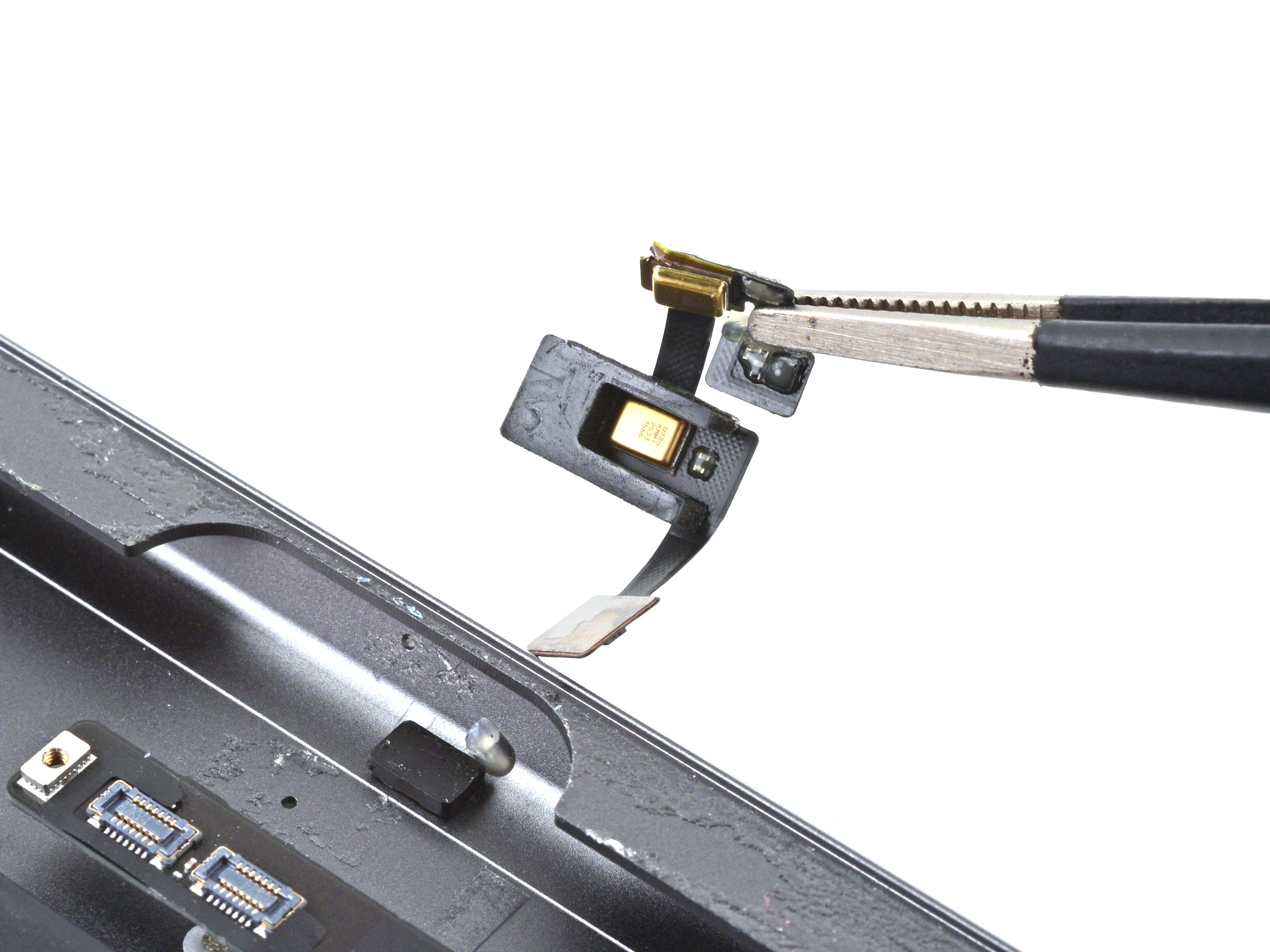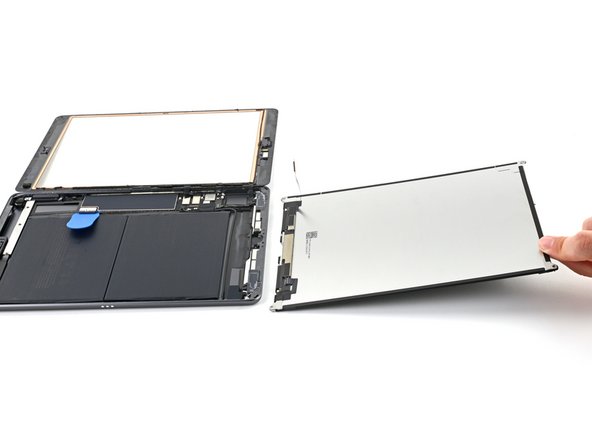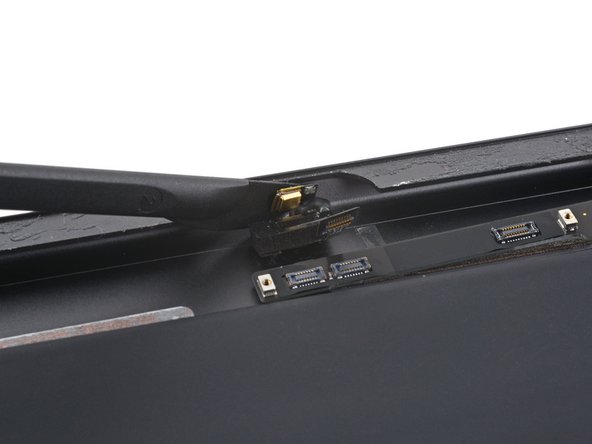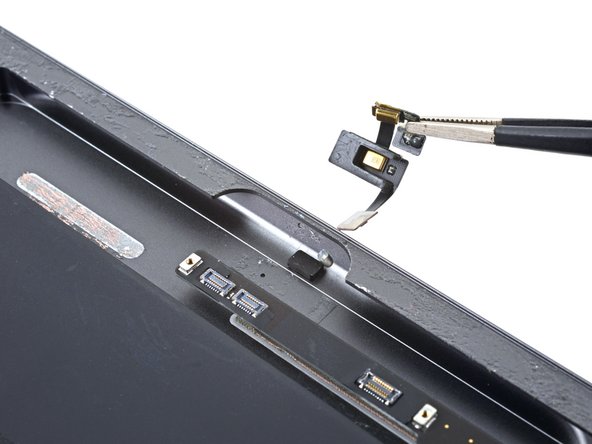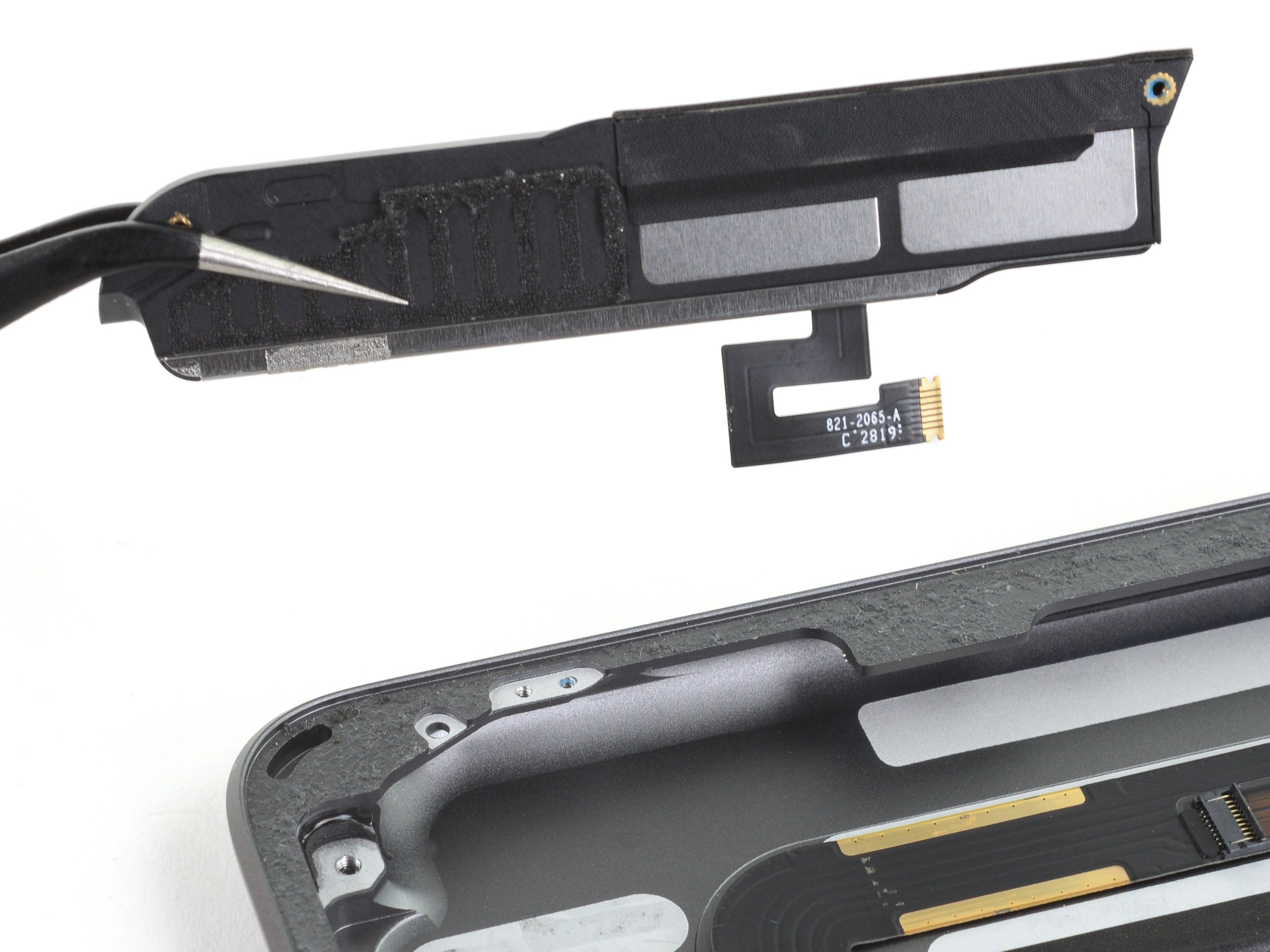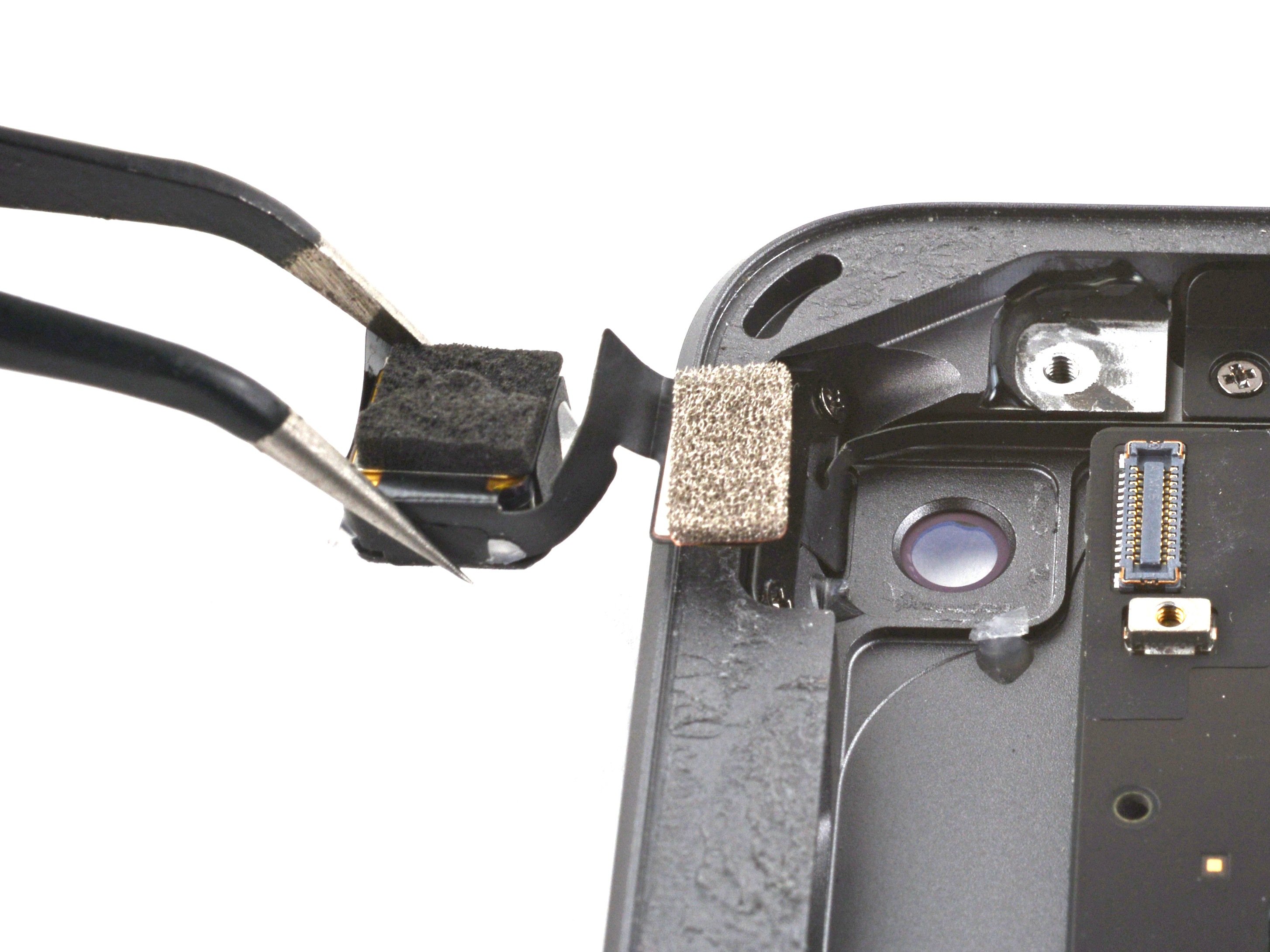iPad 8 Microphone Assembly Replacement
Duration: 45 minutes
Steps: 55 Steps
Before diving into disassembling your iPad, make sure to drain the battery to under 25% for your safety. We want you to stay powered up, but not too much!
Ready to replace the microphone assembly in your iPad 8 Wi-Fi? Awesome! But before you dive in, just a quick reminder: this guide is specifically for the Wi-Fi version of the iPad 8. If you've got the LTE version, you'll want to check out the LTE guide instead. For your safety, make sure to discharge your battery to below 25% before getting started. It's a simple step that helps reduce the risk of a fire in case the battery gets accidentally damaged during the repair. If your battery is looking a little puffy, be extra cautious! And when isolating the battery with a battery blocker, remember to be super gentle—the battery contacts are delicate and could cause permanent damage if mishandled. If you're skipping the battery isolation step, try to avoid using metal tools, unless absolutely necessary (like for removing screws), to prevent shorting the battery or messing up any sensitive circuits. Some of the photos in this guide are from a different model, so they may look a tiny bit different, but don’t worry—they won’t affect your repair journey. If you ever feel stuck, you can always schedule a repair for extra support. Happy repairing!
Step 1
- Warm up that iOpener and give it a cozy two-minute hug on the left edge of your device!
Tools Used
Step 2
- While you're letting the adhesive do its thing and loosen up, keep an eye on these delicate spots that don't love a good pry:
- Front camera
- Antennas
- Display cables
Step 3
Next up, we’ve got the Anti-Clamp in action! This tool is a game-changer for opening your device. If you’re not using the Anti-Clamp, no worries—just skip ahead three steps for a different approach.
Not sure how to use the Anti-Clamp? Check out the full guide right here.
If your iPad’s surface is a bit too slick for the Anti-Clamp to hold onto, just stick some tape on it to give it a little more grip. Easy fix!
- Give that blue handle a gentle tug backward to free the Anti-Clamp's arms.
- Nestle your iPad on a solid surface, ensuring it sits comfortably between the suction cups.
- Place the suction cups near the center of the left edge—one up top and one below.
- Keep the bottom of the Anti-Clamp steady while you press down firmly on the top cup to create a strong suction.
Step 4
- Push the blue handle forward to lock those arms in place. You got this!
- Twist the handle clockwise for a full 360 degrees, or until you feel those cups starting to stretch. Keep going, you’re almost there!
- Double-check that the suction cups stay aligned with each other. If they slip out of line, just loosen them a bit and realign the arms. Easy fix!
Step 5
Take it slow – no need to rush! Turn it just half a turn at a time, and give it a minute between each. Let the Anti-Clamp and the clock do the heavy lifting for you.
For detailed tips on how to wield a hair dryer like a pro, take a peek at this guide.
If the Anti-Clamp isn't doing its magic and leaving you with a snug gap, just crank up the heat a bit more and give that handle a gentle clockwise twist, about half a turn should do the trick.
- Give the adhesive a minute to relax and let that gap start to form. Patience is key!
- If the screen's not warming up enough, a quick blast from a hair dryer along the left edge of your iPad should do the trick.
- Once the Anti-Clamp opens a nice gap, slide an opening pick underneath the digitizer and you're good to go.
- Feel free to skip the next step, you're on track!
Step 6
If your screen is seriously cracked, try sticking a layer of clear packing tape over it to give that suction cup something to grab onto. If that doesn’t do the trick, a super-strong tape can step in as a suction cup substitute. And hey, if all else fails, a little superglue can firmly attach the suction cup to the shattered screen—just be careful!
- When the screen feels warm to the touch, grab your suction handle and stick it right on the left edge, as close to the edge as you can get.
- Gently lift the screen using the suction handle to pop open a tiny gap between the digitizer and the frame.
- Slide an opening pick into that gap between the digitizer and the frame to keep things moving.
Tools Used
Step 7
No worries if the opening pick peeks out from behind the digitizer — just give it a little tug and pull it out. The LCD screen should be just fine, but watch out for any stubborn adhesive that might stick around and be a pain to clean up later.
- Pop a second opening pick into the little gap you just made.
- Gently slide that pick down to the bottom-left corner to loosen up the adhesive.
- Keep the pick in place at the bottom-left so the adhesive doesn’t sneak back together.
Step 8
- If your opening pick gets stuck in the adhesive, try gently 'rolling' it along the edge of the iPad to keep peeling the adhesive away.
Step 9
- Gently glide the first opening pick towards the top-left corner of your device to break free from the adhesive's grip.
- Keep that pick in place at the top-left corner to ensure the adhesive doesn't decide to stick around again.
Step 10
- Warm up your iOpener and give it a cozy hug to the top edge of your device for two minutes.
Tools Used
Step 11
- Gently wiggle the pick around the top-left corner of your device to free up the adhesive. You've got this!
Step 12
Keep that pick away from the front camera! We wouldn't want you to accidentally scratch that lens. Stick with us, and we'll show you how to keep it safe and sound.
- Gently glide the opening pick along the top edge of your device, pausing just shy of the front camera. You're doing great!
Step 13
- Gently pull the pick out until just the tip stays sandwiched between the digitizer and the frame.
- Carefully slide the pick over the front camera to loosen up that stubborn adhesive.
- Keep the pick resting near the right side of the front camera before moving on to the next step.
Step 14
- Slide the pick back in and glide it toward the top-right corner of your device to fully break free the stubborn top adhesive.
- Keep that pick snug in the top-right corner to stop the adhesive from getting all clingy again!
Step 15
- Warm up your trusty iOpener and give it a cozy spot on the right edge of your device for a delightful two-minute spa session.
Tools Used
Step 16
- Gently twist the pick around the top-right corner to loosen up that sticky adhesive.
Step 17
The display cables hang out about halfway up from the bottom of the iPad. When you get to roughly three inches from the bottom, it’s time to stop sliding — you’re right where you need to be!
- Pop in a fresh opening pick and slide it smoothly to the center of the iPad's right edge.
Step 18
- Warm up an iOpener and stick it on the bottom edge of your device for a solid two minutes to get things loosened up.
Tools Used
Step 19
Avoid spinning the pick all the way around the corner—your antenna will thank you for the gentle touch!
- Gently slide the bottom-left pick into the corner to break that adhesive seal.
- Keep the pick in that bottom-left corner before you jump to the next step.
Step 20
Just a friendly reminder: slide that pick towards the home button, not away! We want to keep that antenna safe and sound.
If you find yourself needing to slide that trusty pick over this section again, just pull it out and pop it back in at the bottom-left corner. You've got this!
- Pop a new opening pick into the gap you just made along the bottom edge of the iPad.
- Gently slide the pick past the antenna, stopping right before you hit the home button.
- Pause with the pick resting to the left of the home button before moving on.
Step 21
Gently slide the pick no more than 1 mm in to keep the right antenna safe and sound.
- Gently slide an opening pick into the tiny gap you've just made.
- Now, shimmy that pick underneath the home button and glide it toward the bottom-right corner, ensuring that only the tip is nestled between the digitizer and the frame.
Step 22
Just remember to slide the pick toward the home button—going the other way could give the antenna a bit of a rough time!
If you need to slide the pick over this part again, just pull it out and pop it back in at the bottom-right corner to keep things smooth.
- Slide that pick back in and gently nudge it toward the home button to fully loosen the bottom adhesive.
- Rest the pick just to the right of the home button before moving on to the next step.
Step 23
- Warm up your iOpener and gently press it against the right edge of your device for a solid two minutes. You've got this!
Tools Used
Step 24
Take it slow and steady here. Make sure the adhesive is nice and warm so it’s easy to work with, and carefully slide your pick to separate all the adhesive. If things get tricky, don’t hesitate to pause and reheat before moving on.
If you hit some stubborn spots, just give those edges another quick warm-up and gently slide your opening pick along them.
- Gently twist those two opening picks into the left corners of your iPad. This will give the digitizer a little lift while also nudging away the last bits of adhesive. Easy peasy!
Step 25
- Gently lift the left side of the digitizer to help break the adhesive seal along the right edge of your iPad. You're doing great!
Step 26
- As you hold the digitizer steady, gently slide an opening pick between the two display cables to break free the last bit of adhesive. You're almost there!
Step 27
- After you've carefully loosened all the adhesive, open up the digitizer like a book and lay it flat next to the iPad.
- When putting everything back together, wipe off any leftover adhesive from the frame—and the digitizer if you're reusing it—using some isopropyl alcohol. Then swap in fresh adhesive strips or pre-cut adhesive cards to keep things snug.
- Keep an eye on those display cables while reassembling. Tuck them neatly under the LCD screen so they don't get squished or damaged.
Step 28
- Grab your trusty Phillips screwdriver and tackle those four 4.3 mm-long screws that are keeping the LCD snug in the frame. You've got this!
- As you work your magic, make sure to keep an eye on those screws! They each have their special spot, so return them to their homes to keep your device happy and healthy.
- Don't forget to peel away any tape that's hiding the LCD screws. We want those screws to shine and be accessible!
Step 29
Hold your horses! Don't go yanking that LCD out just yet—it's still happily connected by a flex cable.
- Grab your trusty spudger and gently slide the flat end under the LCD to lift it just enough so you can get a good grip with your fingers.
- Now, flip that LCD over like you're turning a page in a thrilling novel, lifting it near the camera and swinging it over to the home button end of the frame.
- Place the LCD down on a clean, soft, lint-free surface to give those display cables some room to breathe.
Tools Used
Step 30
- Grab your trusty Phillips screwdriver and get ready to work some magic! Carefully unscrew the 2.3 mm-long screw that keeps the battery connector snug against the logic board. You've got this!
Step 31
Check out these pics to see what the battery connector looks like hidden under the logic board. Keep them handy as a guide while you carefully unplug the battery.
Heads up: the battery connector uses cantilever springs on the logic board that press against the battery’s contact pads. Since both the logic board and battery are glued down, you’ll want to slide a thin, flexible tool gently between the contacts to safely disconnect the battery.
Step 32
Handle the battery blocker with care! Those battery contacts are delicate little guys—bend or break them, and they're done for. Keep it gentle to avoid any permanent damage.
Make sure the iFixit logo on the battery blocker is pointing up, just like a good friend waving hello!
Be gentle with the battery blocker—no need to shove it in there like you're trying to win a game! If it feels like a tight squeeze under the logic board, consider using a playing card to disconnect the battery instead. It's a classic move!
Ideally, the battery blocker or playing card should glide effortlessly under the logic board without any hiccups. Once it's in, it should rest at a cool 15-degree angle, just chilling out!
- Slide the battery blocker under the logic board's battery connector at a cool 35-degree angle.
- Keep that battery blocker in place while you get your hands dirty with the rest of the repair!
Tools Used
Step 33
- Grab a Phillips screwdriver and carefully unscrew the three tiny 1.4 mm screws holding down the display cable bracket.
Step 34
- Grab your trusty tweezers or just use your fingers to gently lift off the display cable bracket. You've got this!
Tools Used
Step 35
- Grab the flat end of your spudger and gently pry up to disconnect the LCD cable press connector.
- To snap these press connectors back in, line up one side carefully and press down until you hear a click, then do the same on the other side.
- Avoid pressing in the middle! If the connector is off-center, those pins might bend and cause some serious damage.
Tools Used
Step 36
- Carefully detach the LCD and place it face down on a clean, soft, lint-free surface. You've got this!
Step 37
- Grab your tweezers and carefully lift the tape that’s keeping the home button cable’s ZIF connector under wraps.
Tools Used
Step 38
- Grab a spudger, an opening tool, or even your trusty fingernail and gently lift that little hinged locking flap on the home button cable ZIF connector. It's a simple move, so no stress—you're doing great!
Tools Used
Step 39
- Grab your tweezers and gently pull the home button ribbon cable straight out of the ZIF connector like a pro.
Tools Used
Step 40
Be gentle and pry only on the connectors themselves—avoid poking around the logic board socket to keep your iPad safe and sound.
- Gently use the flat end of your spudger to wiggle and pop off those two digitizer cable press connectors. You've got this!
Tools Used
Step 41
Be super careful not to poke or rip that home button ribbon cable!
- Grab your trusty spudger and gently lift up the vibration isolator located at the bottom-right corner of your device. It's like giving your device a little nudge!
- Once it's up, go ahead and remove that vibration isolator. You're making great progress!
Tools Used
Step 42
The home button cable is held in place with a bit of gentle adhesive.
- Gently use tweezers to lift the home button cable away from the frame — easy does it!
Tools Used
Step 43
Grab an opening pick to carefully slice through any stubborn adhesive still holding the front panel assembly to the frame.
Without the right insulation, parts of the digitizer might short out against other components, which can mess with your touch input.
This insulation is sneaky—it's invisible to the naked eye and not the same as the foam dust barrier strips you often see on iPads.
- First things first, let's get that front panel assembly out of the way!
- If you're dealing with pesky 'ghost' or 'phantom' touches on your brand-new display, don't fret! A simple solution is to apply a super thin layer of insulating tape, like Kapton (polyimide) tape, to the highlighted spots on the back of the panel. Good news - our replacement digitizers come with the right insulation, so you shouldn't need to add any tape!
- When you're putting everything back together, make sure to clear away any leftover adhesive from your iPad. Grab some high concentration isopropyl alcohol (90% or higher) and a lint-free cloth to clean the glued areas. This little prep will help the new adhesive stick like a champ!
- Before you seal everything up, give your iPad a quick test to check all functions, and use our display adhesive application guide to put those pre-cut adhesive strips on the back of the display. You're almost there!
Step 44
- Grab your trusty Phillips screwdriver and get ready to tackle those three tiny screws holding the upper component bracket in place. They're 1.4 mm long, so be sure to stay focused as you unscrew them with care!
Step 45
- Grab your trusty tweezers or just your fingers and gently lift the upper component bracket off the frame. It's like a little dance—just be careful and let it slide right off!
Tools Used
Step 46
- Gently slide the flat end of your spudger under the front camera cable press connector to pop it loose.
Tools Used
Step 47
The front camera shell is gently stuck to the frame, so you might need a little patience to lift it off.
- Slide an opening pick snugly between the front camera shell and the frame. Let’s get that device open!
Step 48
- Gently glide the pick around the edge of the camera shell to break that sticky bond.
Step 49
- Gently wedge the opening pick between the front camera shell and the frame to start loosening it up.
- Carefully lift and take out the front camera shell.
Step 50
The front camera is attached to the microphone assembly using some trusty adhesive.
- Slide a spudger gently between the front camera and microphone assembly.
- Carefully pry to loosen the front camera's adhesive without rushing.
- Lift out the front camera and set it aside.
Tools Used
Step 51
- Grab your spudger and use the flat end to gently lift up and disconnect the microphone cable’s press connector. A little nudge, and it should come right off!
Tools Used
Step 52
- Gently slide an opening pick in between the frame and the bottom edge of the microphone, right by the press connector.
- Carefully work the pick under the microphone, prying upwards to loosen the adhesive and free it.
Step 53
- Gently wiggle a halberd spudger into the gap between the frame and the top edge of the microphone, right along the frame's wall.
- Carefully slide the spudger under the microphone and nudge it sideways to loosen the adhesive holding it in place.
Tools Used
Step 54
There’s a big blob of sticky stuff hanging out on the right side of the microphone; you might need to warm it up a few times to get it to loosen its grip.
- Gently wedge a halberd spudger between the frame and the right edge of the microphone.
- Carefully slide the spudger while lifting to loosen the adhesive.
Tools Used
Step 55
- Time to put your device back together! Just reverse those steps and you'll be golden.
- Got some old gadgets lying around? Make sure to drop them off at an R2 or e-Stewards certified recycler.
- Things didn’t go quite as planned? No worries! Give some basic troubleshooting a shot, or swing by our iPad 8 Answers community for a helping hand.
-
